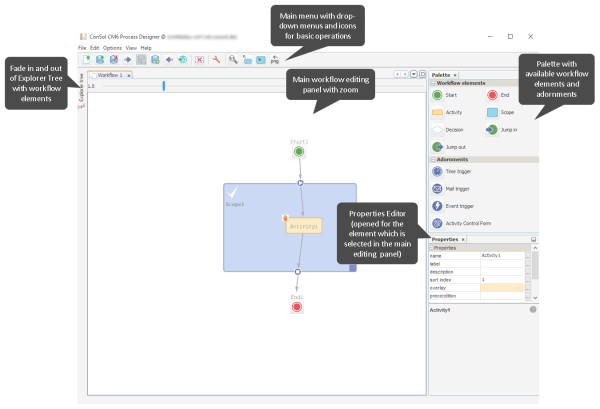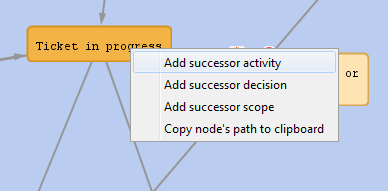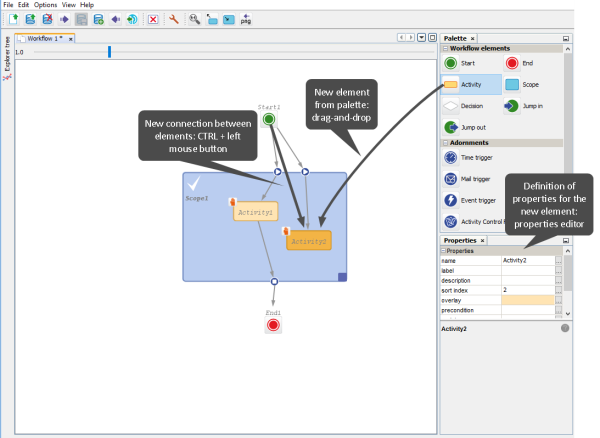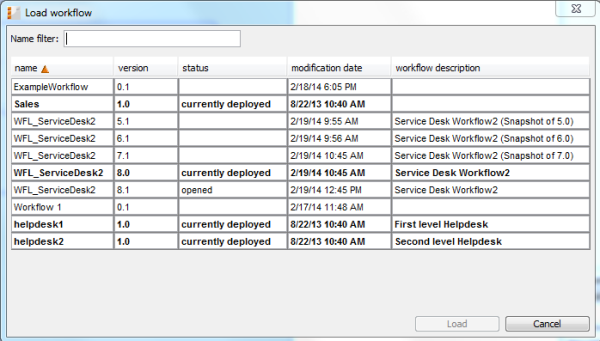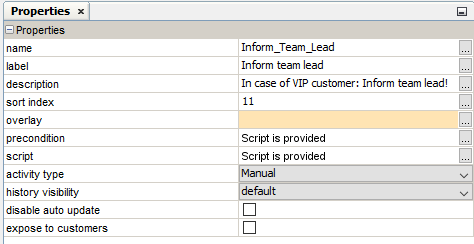Process Designer GUI
GUI elements
GUI sections
The Process Designer GUI contains the following elements, please see the next figure and the list below.
Figure 14: ConSol CM Process Designer - GUI elements
Main menu
The main menu contains the menu items as text entries and a menu icon list.
|
Menu main entry |
Menu sub entry |
Icon |
Note |
|---|---|---|---|
|
File |
New ... |
|
Create a new workflow. |
|
|
Load ... |
|
Load a workflow. Opens table with existing workflows, see section Loading a workflow. |
|
|
Delete ... |
|
Delete a workflow. Opens table with existing workflows, see section Deleting a workflow. |
|
|
Import ... |
|
Import a workflow from a (proprietary workflow format) file. |
|
|
Save ... |
|
Save workflow (existing version). |
|
|
Save as new version |
|
Save the workflow as a new version. |
|
|
Export ... |
|
Export the workflow to a file. Opens file browser of the operation system. The workflow is saved in a proprietary workflow format (.par). |
|
|
Deploy ... |
|
(Save as new version and) deploy the workflow, i.e., install the workflow in the system. The system might prompt you for a decision:
|
|
|
Export to image |
|
Creates an image from the entire workflow as .png file and opens a pop-up menu where you can select the path where to save this png file. Use this functionality for your process documentation. Make sure that the workflow is displayed in the default zoom (1.0) before exporting the image. Otherwise, the image might not include the complete workflow, or the workflow might not use the whole image size. |
|
|
Log in |
|
Log in to the Process Designer. Usually the login window is displayed directly after the start of the Process Designer. As login an account with administrator permissions or with the permissions to manage workflows (see ConSol CM Administrator Manual, section Role Administration) is required. |
|
|
Log out |
|
Log out. Does not exit the Process Designer. |
|
|
Exit |
|
Exit/stop the Process Designer application. |
|
Edit |
Clear current tab |
|
Delete the entire workflow, all elements in the main editing panel. |
|
|
Undo |
|
Reverse the last action which has been done in the Process Designer. Can be disabled in the Local configuration. |
|
Options |
Local configuration |
|
Display pop-up window where you can select the display language of the Process Designer. All languages which have been configured for the system (see section Global Configuration in the ConSol CM Administrator Manual) are available. The labels in the workflow in the main editing panel will be displayed in the selected language. Using the checkbox Disable undo tracking, you can switch off the Undo functionality. Using the checkbox Enable development mode, you can switch on the development mode for script changes. In the development mode changes to scripts become effective immediately after saving the script, i.e. the scripts work as in the Admin Tool. It is not required to deploy the workflow. The element which the script belongs to needs to be available in the last deployed version of the workflow. |
|
View |
Normal zoom |
|
Display workflow in default zoom (like at start of Process Designer). |
|
|
Expand all scopes |
|
Display all scopes in the expanded version. See also GUI tips and tricks section below. |
|
|
Collapse all scopes |
|
Display all scopes in the collapsed version. See also GUI tips and tricks section below. |
|
|
Hide/Show palette |
|
Do (not) display palette in GUI. |
|
|
Hide/Show properties |
|
Do (not) display Properties Editor in GUI. |
|
|
Hide/Show explorer |
|
Do (not) display explorer (tree). |
|
|
Show ticket transfer history |
|
Opens a pop-up window where the parameters for the ticket transfer during the deployment of a new workflow are displayed:
|
|
|
IDE log |
|
Opens the Log File Editor in the lower half of the screen and displays the user-specific log file of the Process Designer: |
|
Help |
About |
|
Display version information about the Process Designer and about the Java virtual machine it uses in the current configuration (this is the JVM of the browser plug-in). |
Workflow editing panel
To design a workflow define the workflow elements using the graphical layout mode of the Process Designer and add the scripts to the elements where required.
A new element can be added to the workflow using drag-and-drop of the element from the palette.
A new element as successor of an existing element can also be created by using the context menu (right mouse click) of an existing element, e.g., for an activity (see the following figure). The new element and the connection to this element will be created.
Figure 15: ConSol CM Process Designer - Context menu for a workflow activity
A new connection between elements is established using the left mouse button while pressing the CTRL key and just drawing the line. If the connection goes from one scope to another, the scope entry and exit points are added automatically.
Figure 16: ConSol CM Process Designer - Adding new elements and connections
You might consider using a global scope for each workflow. Please refer to the Best practices section for more information about how to design good workflows.
Loading a workflow
When you have selected the icon or menu item Load, a table with all available workflows is displayed.
Figure 17: ConSol CM Process Designer - Load a workflow
The table can be sorted based on a column by clicking on the little triangle icon next to the column header.
The table contains the following columns:
- name
The name of the workflow as set in the name property of the workflow (click into the white space around the global scope to see it for a workflow). - version
The version of the workflow. This is assigned automatically by the ConSol CM system. When a scenario has been exported and is imported again, the numbering will start with 1.0 anew. - status
For older workflows this field is empty. The workflows which are deployed are described by currently deployed. - modification date
The date of the last modification (date when the workflow was saved) is indicated. - workflow description
The description which has been entered into the field workflow description (not description!).
To load a workflow, select it in the list and click Load. Only single selection is possible.
Deleting a workflow
When you have selected the icon or menu item Delete, a table with all available workflows is displayed.
Figure 18: ConSol CM Process Designer - Delete a workflow
The table can be sorted based on a column by clicking on the little triangle icon next to the column header.
The table contains the following columns:
- name
The name of the workflow as set in the name property of the workflow (click into the white space around the global scope to see it for a workflow). - version
The version of the workflow. This is assigned automatically by the ConSol CM system. When a scenario has been exported and is imported again, the numbering will start with 1.0 anew. - status
For older workflows this field is empty. The workflows which are deployed are described by currently deployed. - modification date
The date of the last modification (date when the workflow was saved) is indicated. - workflow description
The description which has been entered into the field workflow description (not description!).
To delete one or more workflow(s), select it/them in the list and click Delete. For every workflow you are prompted to confirm the deletion, so when you have marked a great number of workflows to delete and then you realize that you would like to keep one of them this is possible without canceling the entire operation.
You might want to delete all or almost all older workflows before exporting a scenario, because a great number of workflows increases the size of the scenario considerably. For export and import of scenarios, please refer to the respective section in the ConSol CM Administrator Manual.
For an export of a scenario (using the Admin Tool), you might also use the option Only latest/installed versions for workflows. This can reduce the size of the exported scenario considerably, depending on the number of non-active workflows. Nevertheless, it might be a good idea to clean the CM system regarding workflows from time to time to reduce the old data and a potential data overhead.
Palette for elements and adornments
As a default setting the palette is displayed in the top right corner. You can hide (and re-display) the palette using the main menu entry Hide/Show palette under View.
The palette contains two types of workflow components:
- elements
- adornments
Elements
Elements are basic components which form the workflow and represent the process logic.
|
Icon |
Element |
Note |
Section |
|---|---|---|---|
|
|
Start node |
Is set automatically, no other start node than the default start node can be added. |
|
|
|
End node |
A workflow can contain one or more end nodes. |
|
|
|
Activity |
The actions in the workflow, manual or automatic. |
|
|
|
Scope |
The highest hierarchy level in workflows |
|
|
|
Decision |
Decision node which has a true and a false exit point. |
|
|
|
Jump-in |
Entry point for tickets from other workflows/queues. |
|
|
|
Jump-out |
Exit point for tickets. A target queue has to be defined. A target node can be defined but is optional. |
|
|
|
Reopen |
Activity which can be performed for closed tickets. |
Adornments
Adornments are objects which are assigned to a workflow activity or to a scope. Please see indicated sections for detailed explanations.
|
Icon |
Adornment |
Note |
Section |
|---|---|---|---|
|
|
Time trigger |
Can measure time intervals. Fires when the end of the interval has been reached. Can optionally use a business calendar. |
|
|
|
Mail trigger |
Fires when an email for the ticket has come in. |
|
|
|
Business event trigger |
Fires when an event has occurred. The type of event can be specified (e.g., change of engineer, change of priority). |
|
|
|
ACF (Activity Control Form) |
Defines the ACF which should be displayed when the activity is executed. ACFs are defined in the Admin Tool. |
Activity types
Activities can have additional icons to indicate if the activity is manual or there are conditions. Please see indicated sections for detailed explanations.
|
Icon |
Name |
Description |
Section |
|---|---|---|---|
|
|
Manual |
Indicates that the activity is a manual activity, i.e., the engineer has to click it in the Web Client. |
|
|
|
Scope activity |
Indicates that the activity is a scope activity, i.e., that the activity is not bound to a certain chain of activities but is available in the entire scope |
|
|
|
Precondition |
Indicates that the activity has a condition script attached. The condition script is executed when the previous activity has been performed. The activity with the precondition icon is only displayed if the condition script returns true. |
Editing the properties of a workflow element
The properties editor of an element is opened on the right when you click the element in the workflow editing panel. The available settings depend on the selected element.
The following example shows the properties editor of an activity:
Figure 19: ConSol CM Process Designer - Properties editor of an activity
Editing scripts
You use the script editor in the Process Designer to write Groovy scripts (i.e., pure Groovy and Java code is accepted). For explanations, recommendations, and examples concerning workflow programming using scripts, please see section Workflow programming.
Figure 20: ConSol CM Process Designer - Script editor
The script editor provides the following features:
- Syntax highlighting
Groovy code is highlighted according to key words. - Code completion
When you have entered the name of an object and the dot, the possible methods are suggested. Press CTRL + SPACE to activate code completion. - Code check
The entered code is controlled according to the correct use of general syntax and methods. The error code is displayed in the Compilation result panel.
GUI tips and tricks
|
To ... |
do the following ... |
|---|---|
|
expand a single collapsed scope |
Double-click in the scope. |
|
collapse a single expanded scope |
Double-click in the scope. |
|
resize a scope |
Move the handler of the scope (bottom right of the scope). |
|
add a new email trigger to a scope |
Grab the email trigger symbol in the palette with the mouse and drop the newly created email trigger into the respective scope. |
|
add a time trigger to a scope |
Grab the time trigger symbol in the palette with the mouse and drop the newly created time trigger into the respective scope. |
|
add a time trigger to an activity |
Grab the time trigger symbol in the palette with the mouse and drop the newly created time trigger into the respective activity (used e.g., for resubmissions). |
|
delete a connection between two activities |
Mark the connection (not the scope or other surrounding elements!) and press DELETE. |
|
insert a new edge into a connection between two activities |
|
|
copy and paste a scope |
Mark the scope, and either press CTRL+C and CTRL+V or right-click and select Copy element to clipboard and Paste element from clipboard from the context menu. A copy of the scope with all the elements it contains is inserted at the bottom of the workflow. |
|
copy and paste an activity or node |
Mark the activity or node, and either press CTRL+C and CTRL+V or right-click and select Copy element to clipboard and Paste element from clipboard from the context menu. A copy of the activity or node with all its data is inserted at the bottom of the workflow. |
